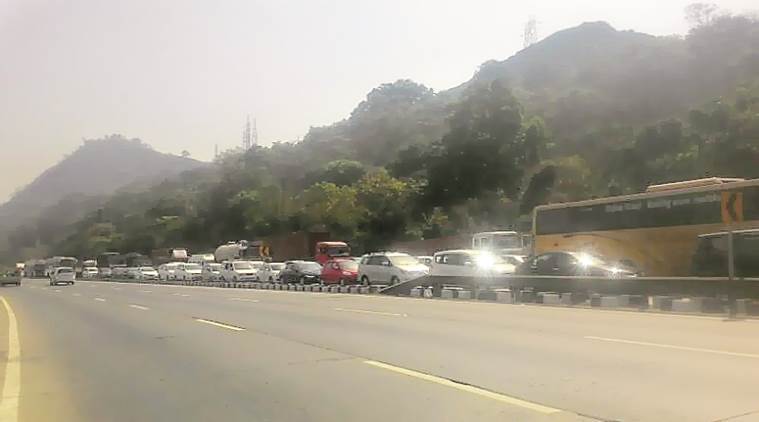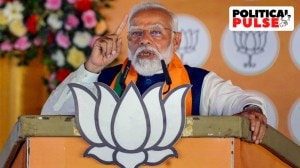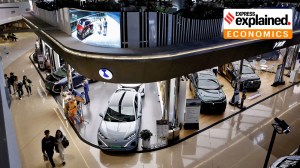- India
- International
Mumbai-Pune expressway: First road set to be governed by AI-based traffic system
The ITMS for the expressway, connecting the two cities, has been designed with an intention of reducing accidents. At its core, the system will detect and punish traffic offences without manual intervention, reducing manpower needed to police the 95-km-long stretch.
 The police expect the state Cabinet to clear the proposal by the end of August and for the system to be operational in six months before a similar system for Mumbai — approved by the state Cabinet on Tuesday — gets underway. (File)
The police expect the state Cabinet to clear the proposal by the end of August and for the system to be operational in six months before a similar system for Mumbai — approved by the state Cabinet on Tuesday — gets underway. (File)
The Mumba-Pune Expressway is set become the first stretch of road in the state to get an Intelligent Traffic Management System (ITMS).
The police expect the state Cabinet to clear the proposal by the end of August and for the system to be operational in six months before a similar system for Mumbai — approved by the state Cabinet on Tuesday — gets underway. The Rs 891-crore project for Mumbai is not expected to be operational for at least a year, as it will require installation of 4,705 new smart traffic signals at 617 junctions.
The ITMS for the expressway, connecting the two cities, has been designed with an intention of reducing accidents. At its core, the system will detect and punish traffic offences without manual intervention, reducing manpower needed to police the 95-km-long stretch.
Between January 2016 and July this year, 483 people were killed in 381 accidents, while another 657 people were seriously injured in 319 mishaps. The police have attributed a majority of these accidents to speeding and lane-cutting.
Vijay Patil, the SP of the state highway police, told The Indian Express that the system will comprise a series of radar-based sensors and cameras to capture speed and lane-cutting violations.

“Motorists have become so fed up with traffic congestion in Mumbai and Pune that they step on the accelerator as soon as they enter the expressway. They do not take into consideration the capacity of their cars or other vehicles around them,” said Patil.
The police plan to install cameras at all entrances and exits to the expressway as well as the toll plazas. The Artificial Intelligence-enabled cameras will be linked to the e-challan system to automatically generate fines once traffic offences are detected. The SP said once drivers realise that they are being watched by cameras in spite of policemen not being present, they will automatically start following traffic rules.
The police expect the system to curb rampant lane-cutting. “We will also place cameras on those sections of the expressway where lane-cutting frequently leads to accidents. The cameras will record data on what type of vehicles ply on which lanes. Using automatic numberplate recognition, details of offending vehicles will be captured and e-challans sent to the drivers,” said Patil.
“At present, heavy vehicles drive on the first lane, forcing lighter vehicles to cut on to the second and third lanes to get ahead. Several accidents take place because vehicles ram into each other from the rear while jumping lanes,” he added.
The ITMS system has been designed after studying models in other cities that have been successful in establishing lane discipline and curbing the practice of driving on the wrong side, said police.
However, a major concern for the police remains controlling access on the expressway, with two-wheelers and animals able to enter the stretch at certain exits.
Patil said that though the expressway is off limits to two-wheelers, residents of certain villages along the road regularly break holes in boundary walls. “Even after we get the holes repaired, villagers make new holes the very next day. Now, the cameras will identify offenders and they would be arrested,” he added.
Besides, the police plan to build rumbler strips on the shoulders of the road to prevent accidents. “Since the entry of heavy vehicles is prohibited inside cities between 9 pm and 9 am, truck drivers are compelled to drive at night when they inevitably become sleepy. If a truck veers into the shoulder, the rumbler strips are sure to wake up a drowsy driver before he hits the crash barriers,” said Patil.
According to the police’s proposal, the project will require a capital expenditure of Rs 40 crore to install cameras, sensors and software. An additional five-year contract worth Rs 50 crore is required to operate and maintain the system. “Once the system is operational, we expect accidents to reduce by 10 per cent,” Patil said.
The ITMS is also expected to be installed in the proposed Samruddhi Corridor between Mumbai and Nagpur.
Apr 16: Latest News
- 01
- 02
- 03
- 04
- 05






































